Pros
Cons
Introduction
Product Overview
{{section_header}}{{section.name}}{{/section_header}}
The first thing you'll notice about the Bose MIE2s is they have a bit of a unique shape. Not only are their sleeves shaped like funnels, but they have little rubbery bits sticking out. Different companies have different proprietary names for this increasingly ubiquitous design flourish, but we're calling them crux fins because they're fin-shaped and fit underneath the crux of your helix.
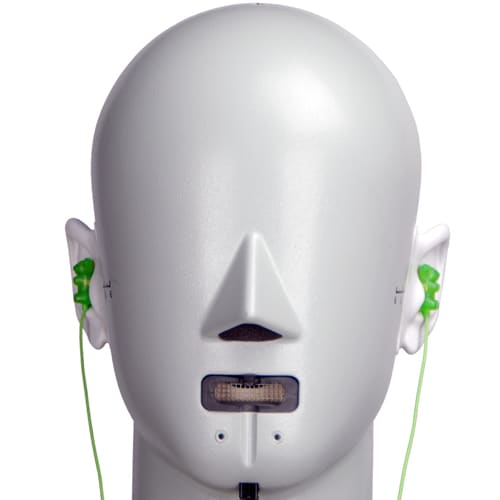
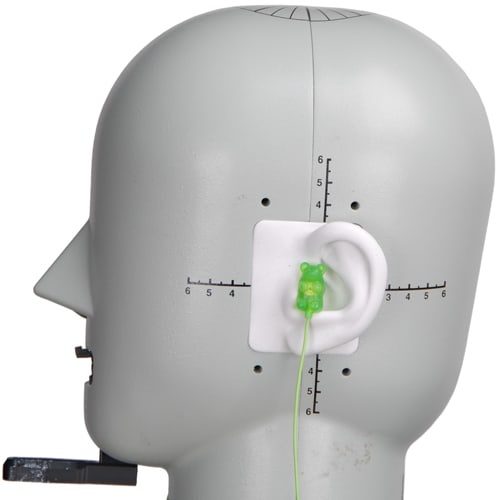
Speakers
{{section_header}}{{section.name}}{{/section_header}}
Aside from the crux fins, the ear buds themselves have a slightly odd shape. They're a bit bigger than we're used to, which we're sure gives them unique sonic qualities and makes them truly unique snowflakes.
Sides
{{section_header}}{{section.name}}{{/section_header}}
Back
{{section_header}}{{section.name}}{{/section_header}}
Band
{{section_header}}{{section.name}}{{/section_header}}
Cable
{{section_header}}{{section.name}}{{/section_header}}
The headphones also have a small control pendant in-line you can use to control media playback or basic call functionality on your phone.

The headphones dead-end in a typical 1/8-inch plug.
Additional Features
{{section_header}}{{section.name}}{{/section_header}}
In the Box
{{section_header}}{{section.name}}{{/section_header}}
In the Bose MIE2 box you'll find the headphones, a traveling case, five additional sets of sleeves, and two 2.5mm adapters for cell phone compatibility.
Durability
{{section_header}}{{section.name}}{{/section_header}}
The Bose MIE2 headphones aren't very durable. This isn't so much a fault of their own as it is a weakness of the in-ear design. The things are meant to be portable, and small bits of lightweight plastic and thin gauge cable don't tend to hold up very well to abuse. The areas in-ears tend to be the weakest are where the cable runs into the ear buds, plug, or any in-line accessories. Those regions typically have a thicker insulation around the cable. The thicker insulation keeps the cable from bending too sharply, which causes a great deal of wear and tear on the internal wiring. The Bose MIE2s don't have the most robust cord guards in these areas, which means you might want to think twice before just balling these things up and shoving them in your pocket. If you want to stretch out your MIE2s' lifespan, stow them away in their included case.
Aesthetics
{{section_header}}{{section.name}}{{/section_header}}
The MIE2s look fine for a set of in-ears. Their form factor doesn't leave much surface area to decorate, but Bose did a good enough job, putting some classy design flourishes on the outside of the ear buds. Frankly though, there isn't a lot you can do to make a set of in-ears really grab the eye unless you a.) put a huge logo on the side that you've painstakingly marketed as a designer brand, or b.) encrust them with the finest jewels, or c.) encrust them with obnoxious flashing LEDs. Bose tends to favor option A, but the branding isn't big enough to be gaudy. Overall, they're attractive, but not gorgeous.
Frequency Response
{{section_header}}{{section.name}}{{/section_header}}
The Bose MIE2s didn't have the best frequency response. For starters, the headphones really boost the bass. Many users like a heightened bass response, but the MIE2s—like many in-ears—overdo it. From there, the curve falls off into a more reasonable range (between the dotted lines), but continues to fall below where it should. Interestingly enough, the Bose headphones don't give a particularly noticeable boost around the 7kHz range, which is typical for in-ears. Instead, that band is still slightly underemphasized: don't expect particularly punchy drums. The headphones give a bit of a boost around 9kHz, but then the response drops down again for the 10kHz mark. All in all, this is kind of a weird frequency response. The MIE2s don't follow the standard rules for dynamic in-ears. The dynamic response is also a bit excessive, leaving some frequency bands overemphasized and some underemphasized: there really shouldn't be a 40dB spread between the two.

Click here for more information on our frequency response test.
Distortion
{{section_header}}{{section.name}}{{/section_header}}
Barely anything of note. There's a small distortion spike, in the low end, but it's nothing anyone would notice. Great performance here.
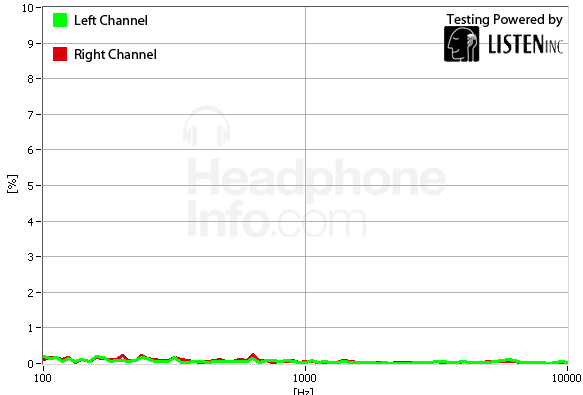
Click here for more information on our frequency response test.
Tracking
{{section_header}}{{section.name}}{{/section_header}}
The headphones seem to favor the left just slightly. Even at its least even, however, the left channel is only 5dB louder than the right—this isn't a huge margin. The volume also doesn't shift suddenly throughout the frequency spectrum. While these headphones aren't perfect, they also aren't terrible.
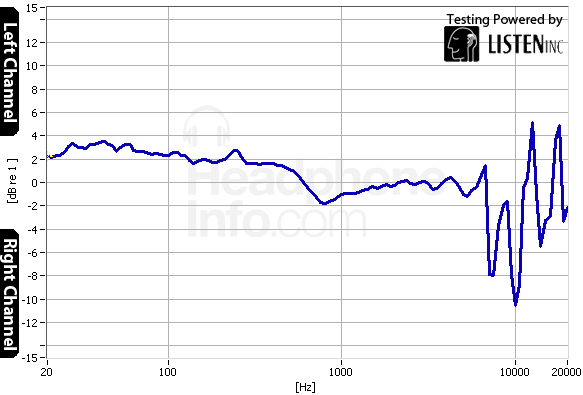
Click here for more information on our frequency response test.
Isolation
{{section_header}}{{section.name}}{{/section_header}}
The Bose MIE2s and their weird sleeves (the rubbery bits that fit on the ear buds) don't block out much external noise. They don't stop many bass sounds, and their passive isolation doesn't really do much until the 1kHz mark. If you need to keep external noise external and you don't want ambience interrupting your music, the MIE2s might not be for you.

Click here for more information on our isolation test.
Leakage
{{section_header}}{{section.name}}{{/section_header}}
The Bose MIE2s leak more than we would've expected for a set of in-ears. We wouldn't recommend listening to loud music in quiet public areas, like museums or libraries: others will definitely hear your playback.
Click here for more information on our leakage test.
Maximum Usable Volume
{{section_header}}{{section.name}}{{/section_header}}
The Bose MIE2 headphones had a pretty decent maximum usable volume: 119.64dB. We award maximum points for 120dB; anything more than that is harmful to your hearing. While the headphones can get a bit louder, it'll increase distortion to annoyingly audible levels.
Click here for more on our maximum usable volume test
Short-Term Use
{{section_header}}{{section.name}}{{/section_header}}
The Bose MIE2s aren't uncomfortable, but they aren't really comfortable either. For starters, they involve sticking a foreign object into your ears, which isn't very comfortable. Further, they don't stick into your ear far enough. That might sound a bit like a catch-22, but it's not. Sticking bits of rubber into your ear is just a necessary evil for in-ears, because it helps them stay in place securely. The Bose MIE2s and their weird design try to get around the discomfort of ear intrusion by looping rubber through the fleshy folds of your ear. This doesn't work to keep things in place, really. It'll stop the headphones from popping out of your ears completely, but it won't stop them from jarring out of place.

Extended Use
{{section_header}}{{section.name}}{{/section_header}}
Not much changed over a period of six hours: the headphones felt about the same. Readjusting them was a bit annoying and definitely happened more frequently than with traditional ear canal in-ears. If you hate sticking stuff in your ears, though, the MIE2s aren't a bad choice. They have a significantly better design than the old iPod headphones that just balance precariously outside your ear canal.
Customizability
{{section_header}}{{section.name}}{{/section_header}}
Like most in-ears, the MIE2s come with a few extra sets of sleeves. Some have crux fins and some don't. Unfortunately none are very easy to photograph since they're white and we're headphone reviewers, not camera magicians. What the MIE2s don't come with is a normal set of sleeves: even the "regular" sleeves have that weird curved taper to them, like the mouthpiece of a sippy-cup. The sleeves that don't have dorsal fins are definitely worse than the ones that do, unfortunately: that vertical bit of rubber is really the only thing keeping these headphones in the vicinity of your ear.
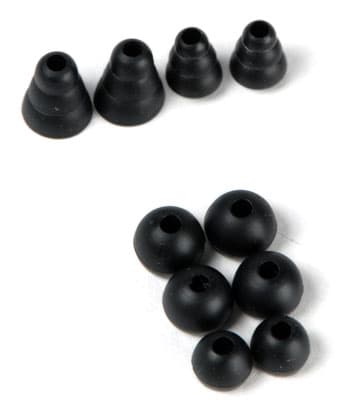
Cable Connectivity
{{section_header}}{{section.name}}{{/section_header}}
The Bose MIE2 headphones have a long enough cable to reach your front pocket comfortably, but don't have so much slack they start to become cumbersome. The headphones also come with two 2.5mm adapters, to let you hook up to the handful of cell phones that don't support a normal 1/8-inch plug.
Portability
{{section_header}}{{section.name}}{{/section_header}}
As in-ears, these headphones are very, very portable. Additionally, they come with a travel case, which should help keep your sleeves together and prevent needless wear and tear from ruining your cable.
Maintenance
{{section_header}}{{section.name}}{{/section_header}}
There isn't much you can do to maintain your Bose MIE2s. They don't come with any cleaning tools, or any features designed to keep the headphones clean or at least in good repair. You can't disassemble the headphones aside from swapping between different sets of sleeves.
Other Features
{{section_header}}{{section.name}}{{/section_header}}
Battery
The Bose MIE2 headphones don't require any batteries. Since batteries are annoying and require additional maintenance, we award any battery-free set of headphones some points.
Remote & Mic
The Bose MIE2 headphones have a remote and mic located at the neck split. The pendant has three buttons. The top and bottom buttons will toggle the volume, and the center button is your playback control. One click is pause/unpause, two is fast-forward, and three is rewind.
Design
{{section_header}}{{section.name}}{{/section_header}}
The Shure SE535 headphones feature a much better design than the Bose MIE2 headphones. The Shure's cable can detach from the ear buds, which helps you replace the cable without also having to swap out the actual expensive bits.
Frequency Response
{{section_header}}{{section.name}}{{/section_header}}
The Shure SE535s had a significantly more consistent frequency response.
Distortion
{{section_header}}{{section.name}}{{/section_header}}
Neither set of headphones had many issues with distortion.
Tracking
{{section_header}}{{section.name}}{{/section_header}}
The Shure SE535 had less issues with its tracking.
Isolation
{{section_header}}{{section.name}}{{/section_header}}
The Shure 535 headphones were much, much better at blocking out ambient light.
Comfort
{{section_header}}{{section.name}}{{/section_header}}
The Shure SE535s don't stick in as well as their predecessors, but they're still more comfortable and secure than the MIE2s. The only way we'd say the MIE2s were more comfortable is if you hate looping the headphone cable around the back of your ears. The Shure SE535s are meant to be worn this way, and feel a bit weird if you don't.
Verdict
{{section_header}}{{section.name}}{{/section_header}}
The SE 535s are significantly better than the Bose MIE2s. They feature better performance and significantly better construction, but their price reflects this. If you're looking for better headphones but don't necessarily wand a super high-end item, the Bose MIE2s are the better choice—but if that's the case, we have to warn you: the MIE2s aren't the best choice either, since there are many better headphones that cost less.
Design
{{section_header}}{{section.name}}{{/section_header}}
The MIE2s definitely have more of a design to them than the Etymotic hf3s, which look somewhat plain. The hf3s have a smaller design, however, and are ever-so-slightly more portable. We also like the hf3s' remote & mic positioning better than what you'll find on the Bose MIE2s.
Frequency Response
{{section_header}}{{section.name}}{{/section_header}}
The hf3s have a much more even keel to their frequency response.
Distortion
{{section_header}}{{section.name}}{{/section_header}}
Neither set of headphones has an issue with distortion.
Tracking
{{section_header}}{{section.name}}{{/section_header}}
The hf3s have a pretty impeccable tracking. While the MIE2s aren't necessarily horrible in this regard, the hf3s are simply better.
Isolation
{{section_header}}{{section.name}}{{/section_header}}
The hf3s block out significantly more noise than the MIE2s.
Comfort
{{section_header}}{{section.name}}{{/section_header}}
The hf3s are more comfortable if you don't mind headphones actually entering your ears. The hf3s fit deep into the ear canal and feature sleeves that are best worn in this way. The result is a set of headphones that isolate very well and also stick in easily. The MIE2s pulled free much more easily, sometimes with just a gentle tug on the cord.
Verdict
{{section_header}}{{section.name}}{{/section_header}}
The hf3s are priced at about the same point as the MIE2s, which make the hf3s almost a strictly better set of headphones. We'd recommend them over the MIE2s.
Design
{{section_header}}{{section.name}}{{/section_header}}
The Bose MIE2s and Sennheiser CX 680is feature similar designs, but one is simply executed better. Both have rubber claw-like appendages that stick out, but while the MIE2s pretty much rely on them to keep the headphones in your ears, the CX 680is just use them to augment an otherwise capable set of headphones. The MIE2s' sleeves are oddly tapered and don't have anything to really grip the inside of your ear, making their hooks significantly more integral in keeping the headphones from falling out. The problem here is, while they'll help keep the headphones from falling out of your ears, they won't keep the headphones from falling out of place. If you love constantly readjusting your headphones, you'll love the Bose MIE2s!
Frequency Response
{{section_header}}{{section.name}}{{/section_header}}
Neither set of headphones had the best frequency response. The CX 680is were much more consistent in terms of maintaining an even response, but the individual channels weren't as in sync.
Distortion
{{section_header}}{{section.name}}{{/section_header}}
Neither set of headphones had any issues with distortion.
Tracking
{{section_header}}{{section.name}}{{/section_header}}
The MIE2s had more consistent volume levels. The CX 680is got slightly louder in the left ear towards the high frequencies.
Isolation
{{section_header}}{{section.name}}{{/section_header}}
The CX 680is isolate far better than the MIE2s.
Comfort
{{section_header}}{{section.name}}{{/section_header}}
Since the CX 680is actually stayed in our ears without having to constantly reposition them, they were the more comfortable set of headphones.
Verdict
{{section_header}}{{section.name}}{{/section_header}}
The CX 680is are a bit cheaper than the MIE2s and put up a marginally weaker audio performance. The deciding factor here will be how the headphones fit you, and if your headphone preferences are anything like ours, the CX 680is win based on this factor alone.
Design
{{section_header}}{{section.name}}{{/section_header}}
The CX 980s have a more complicated and intricate design, but we're not sure it's necessarily more attractive. We definitely like the MIE2s' control pendant better than the CX 980s', based solely on looks alone. We also like the MIE2s' control pendant because it can control playback in addition to volume.
Frequency Response
{{section_header}}{{section.name}}{{/section_header}}
These headphones had very similar frequency responses. The CX 980s didn't underemphasize their high end as much as the MIE2s did, however.
Distortion
{{section_header}}{{section.name}}{{/section_header}}
Neither set of headphones had any issues with distortion.
Tracking
{{section_header}}{{section.name}}{{/section_header}}
Both headphones had roughly the same tracking performance.
Isolation
{{section_header}}{{section.name}}{{/section_header}}
The CX 980s blocked out a bit more sound than the MIE2s did.
Comfort
{{section_header}}{{section.name}}{{/section_header}}
We thought the CX 980s were a bit more comfortable than the MIE2s, but not by that much. Both headphones had issues with falling out of place too easily.
Verdict
{{section_header}}{{section.name}}{{/section_header}}
The CX 980s have better audio quality, but they definitely charge for the privilege. If you want to save some money and don't mind taking a bit of a hit to your sound, the MIE2s are the better choice.
Conclusion
{{section_header}}{{section.name}}{{/section_header}}
The Bose MIE2 in-ear headphones don't really have anything that grabs us. They had decent performance results, but not by a stretch that set them apart from the crowd. The only unique aspect of the MIE2s is their weird sleeve shape, and we didn't think they were particularly comfortable. While the MIE2s aren't bad headphones, they're simply not good enough to merit a purchase when there's other, better headphones for a similar or lower price. At this price point, we'd recommend the Etymotic hf3s.
Meet the tester
Mark Brezinski works on the Home Team, reviewing refrigerators, minifridges, dishwashers, washing machines, dryers, air conditioners, air purifiers, and fans.
Checking our work.
Our team is here to help you buy the best stuff and love what you own. Our writers, editors, and experts obsess over the products we cover to make sure you're confident and satisfied. Have a different opinion about something we recommend? Email us and we'll compare notes.
Shoot us an email